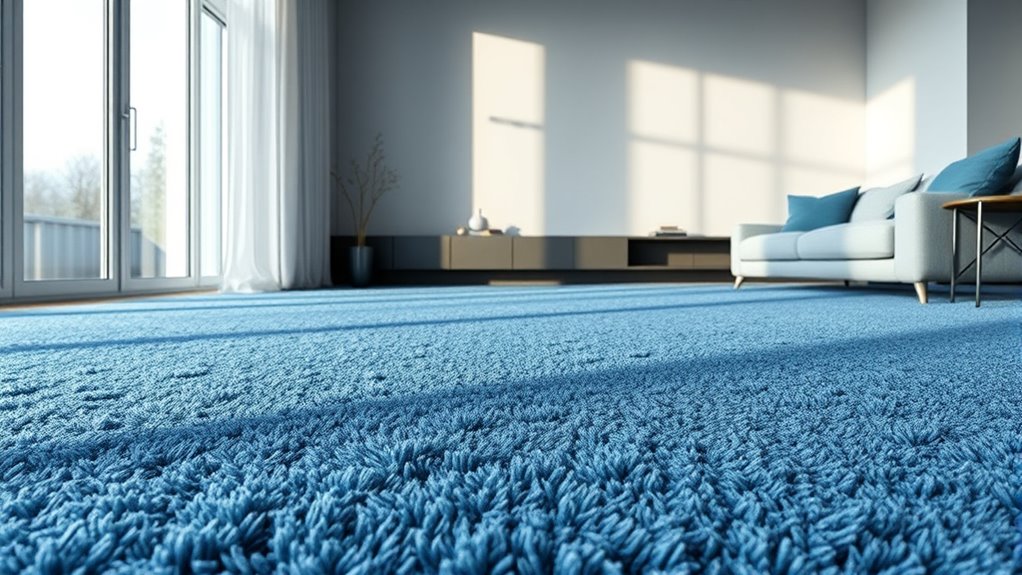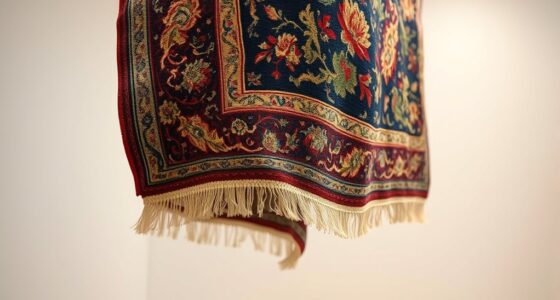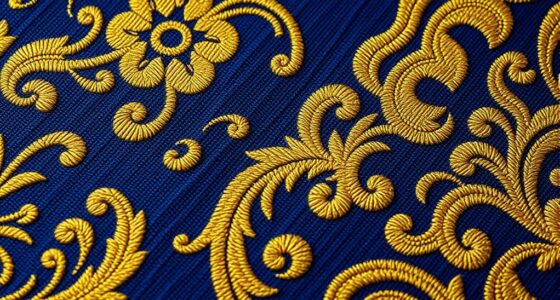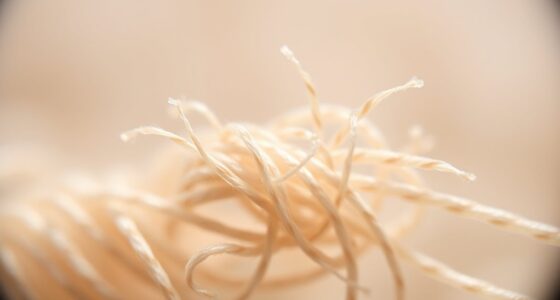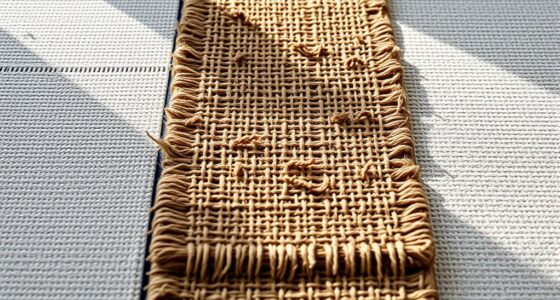Future self-cleaning carpet fibers utilize nanotechnology, hydrophobic coatings, and photocatalytic materials to keep surfaces spotless with minimal effort. These innovations can repel liquids, break down dirt and pollutants, and inhibit microbial growth, transforming maintenance routines. As materials become more durable and eco-friendly, expect carpets that stay cleaner longer and improve indoor air quality. Curious about how these smart fibers will impact your space? Keep exploring to discover the exciting advancements coming your way.
Key Takeaways
- Advances in nanotechnology enable durable, eco-friendly hydrophobic and photocatalytic coatings for self-cleaning fibers.
- Future fibers will actively decompose dirt and repel liquids, reducing maintenance and improving indoor air quality.
- Scalability and cost-effective manufacturing will expand self-cleaning carpet applications in commercial and public spaces.
- Innovations aim to enhance fiber longevity, environmental safety, and recyclability, supporting sustainable deployment.
- Increased regulatory acceptance and awareness will drive adoption of smart, self-cleaning carpets across various industries.
The Science Behind Self-Cleaning Fibers

Self-cleaning fibers work because they incorporate special coatings or materials that actively repel dirt, water, and stains. These fibers are often infused with nanotechnology or photoactive compounds that respond to environmental stimuli. For example, some fibers contain hydrophobic coatings, making water and liquids bead up and roll off before soaking in. Others utilize photocatalytic materials like titanium dioxide, which break down organic dirt when exposed to light. This process prevents stains from setting and keeps carpets cleaner longer. The fibers’ structures are designed at a microscopic level to maximize surface area, enhancing their ability to shed debris naturally. Additionally, understanding ethical hacking principles can help in developing secure manufacturing processes for these advanced fibers, ensuring they are protected from potential cyber threats. By integrating these scientific principles, self-cleaning fibers offer a smarter, more efficient way to maintain carpets without constant cleaning efforts.
Types of Self-Cleaning Technologies in Carpets

Several innovative technologies are driving the development of self-cleaning carpets, each employing different mechanisms to keep fibers free of dirt and stains. Photocatalytic coatings use light-activated reactions to break down organic matter, making dirt easier to remove. Superhydrophobic surfaces repel water and liquids, preventing stains from setting in. Some carpets incorporate antimicrobial agents that inhibit bacterial growth, reducing odors and microbial buildup. Others utilize electrostatic methods, causing dust and particles to loosen from fibers for easier vacuuming or washing. Additionally, nanotechnology enables the creation of surfaces that actively break down dirt molecules, maintaining cleanliness with minimal effort. The integration of automation technologies in carpet maintenance can further enhance the efficiency of self-cleaning systems. Each of these technologies offers unique advantages, allowing carpets to stay cleaner longer and reducing the need for frequent deep cleaning.
Materials Used in Developing Self-Cleaning Fibers

You’ll find that materials like photocatalytic coatings, nanostructured substances, and hydrophobic treatments play key roles in creating self-cleaning fibers. These innovations enable carpets to resist stains, break down dirt, and repel water effectively. Understanding how these materials work together is essential to advancing future carpet technologies. Additionally, incorporating advanced fraud detection techniques can help manufacturers protect their innovations from intellectual property theft and counterfeit products.
Photocatalytic Coatings
Photocatalytic coatings play a essential role in developing self-cleaning carpet fibers by actively breaking down dirt, stains, and pollutants when exposed to light. These coatings typically contain materials like titanium dioxide (TiO₂), which acts as a catalyst under UV or visible light. When illuminated, the coating generates reactive oxygen species that decompose organic matter, bacteria, and other contaminants on the fiber surface. This process not only cleans the fibers but also inhibits microbial growth, maintaining a fresher environment. You’ll find these coatings applied as thin layers on fiber surfaces, ensuring durability without affecting texture or color. Their effectiveness depends on factors like particle size, coating uniformity, and light exposure. Additionally, the choice of fiber materials influences how well the photocatalytic coatings adhere and perform over time. Photocatalytic coatings represent a promising, eco-friendly approach to achieving long-lasting, low-maintenance cleanliness in carpets.
Nanostructured Materials
Nanostructured materials have revolutionized the development of self-cleaning fibers by providing enhanced surface properties that enable dirt and microbes to be repelled or broken down more efficiently. These materials feature features at the nanometer scale, creating a larger surface area and unique topographies that improve interaction with contaminants. For example, nanostructured titanium dioxide or silica can increase photocatalytic activity, breaking down organic stains and killing bacteria upon exposure to light. You’ll find that incorporating nanomaterials improves durability, maintains surface roughness, and enhances functionality without adding bulk. This precise engineering allows fibers to actively resist soiling and microbial growth, reducing cleaning needs. Additionally, advancements in material engineering are enabling the development of fibers with tailored nanostructures that optimize self-cleaning capabilities. As researchers continue refining these nanostructures, expect even more effective, long-lasting self-cleaning textiles that stay cleaner longer and require less maintenance.
Hydrophobic Treatments
Hydrophobic treatments are essential materials that give fibers water-repellent properties, enabling self-cleaning functions. These coatings create a barrier that prevents water and liquids from soaking into the fibers, so stains and dirt don’t adhere easily. Commonly, silicone-based or fluoropolymer compounds are applied to textile surfaces to achieve this effect. By modifying the fiber surface at a molecular level, hydrophobic treatments cause water droplets to bead up and roll off, carrying dirt particles away. This reduces the need for frequent cleaning and prolongs the lifespan of carpets. You’ll find these treatments in many high-performance fabrics today, especially in environments prone to spills or dirt. As research advances, hydrophobic treatments are becoming more sustainable and durable, making self-cleaning carpets more practical and accessible.
Benefits of Self-Cleaning Carpet Solutions

Self-cleaning carpet fibers can considerably cut down your maintenance time and effort, making upkeep easier and less frequent. They also help improve indoor air quality by reducing dust and allergens trapped in the fibers. With these benefits, your living space becomes cleaner and healthier effortlessly. Additionally, innovative technologies harness vibration and self-cleaning mechanisms inspired by natural processes, further enhancing their effectiveness vibrational alignment.
Reduced Maintenance Efforts
Self-cleaning carpet fibers substantially reduce the time and effort needed to maintain your carpets. With these innovative fibers, you won’t need frequent deep cleanings or constant spot treatments. Dirt, dust, and stains are automatically removed or repelled, keeping your carpets looking fresh longer. This means less vacuuming and fewer harsh cleaning chemicals, saving you both time and money. You’ll spend less energy on regular upkeep and avoid the hassle of stubborn stains that require intensive scrubbing. The self-cleaning technology continuously works behind the scenes, maintaining the appearance and cleanliness of your carpets with minimal intervention. Additionally, these fibers align with personal development principles by reducing stress associated with cleaning chores and promoting a more relaxed, inviting environment. Overall, this advancement simplifies your routine, allowing you to enjoy a cleaner, more inviting space without the ongoing maintenance challenges.
Improved Indoor Air Quality
Because carpets often trap dust, allergens, and other airborne particles, maintaining indoor air quality can be a challenge. Self-cleaning carpet fibers help improve this by reducing the buildup of pollutants. Here’s how they make a difference:
- They repel dust, preventing it from settling deep within the fibers.
- They neutralize allergens, reducing respiratory irritations.
- They inhibit mold and bacteria growth, keeping the environment healthier.
- They cut down on the need for frequent deep cleaning, lowering airborne dust during maintenance.
- Advanced filtration systems incorporated into these fibers further enhance their ability to trap and eliminate airborne contaminants.
With these innovations, you breathe cleaner air daily, especially in spaces with high foot traffic. Self-cleaning carpets contribute to a fresher, healthier indoor environment, making your home or office more comfortable and safe.
Challenges and Limitations of Current Technologies
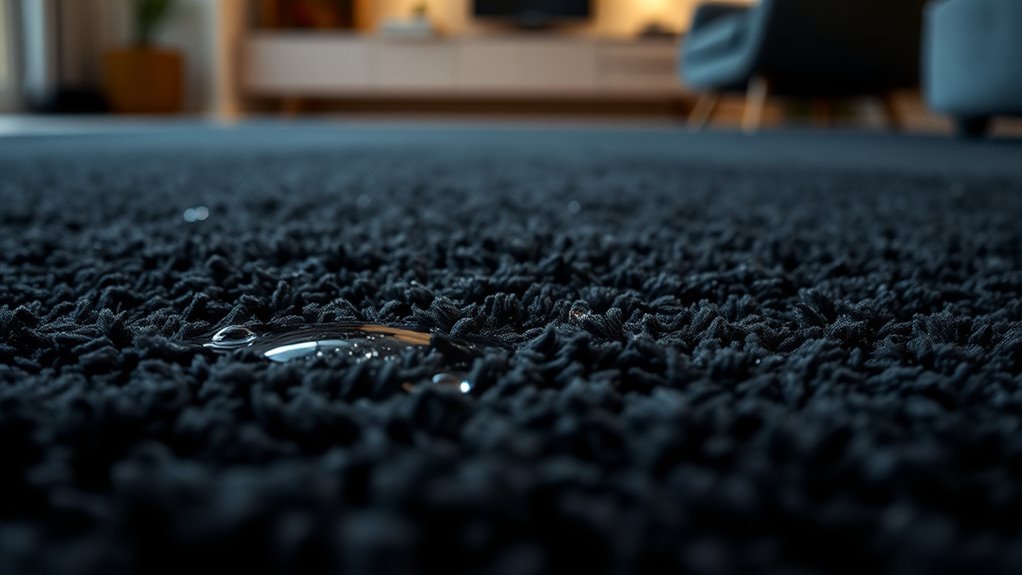
While self-cleaning carpet fibers show promising potential, current technologies still face significant challenges that hinder widespread adoption. One major hurdle is durability; many self-cleaning treatments wear off over time, reducing effectiveness and requiring frequent reapplication. Additionally, the manufacturing processes can be complex and costly, making the carpets less affordable for consumers. Compatibility with existing carpet materials also poses issues, as some fibers don’t respond well to the cleaning agents or coatings used. Environmental factors, such as exposure to sunlight or moisture, can degrade the self-cleaning properties. Moreover, the long-term safety of chemical coatings remains under scrutiny, raising concerns about potential health risks. Furthermore, divorce statistics can influence consumer priorities and perceptions of long-term product value. These limitations mean that, despite advancements, self-cleaning carpets are not yet a practical solution for all settings.
Environmental Impact and Sustainability Considerations
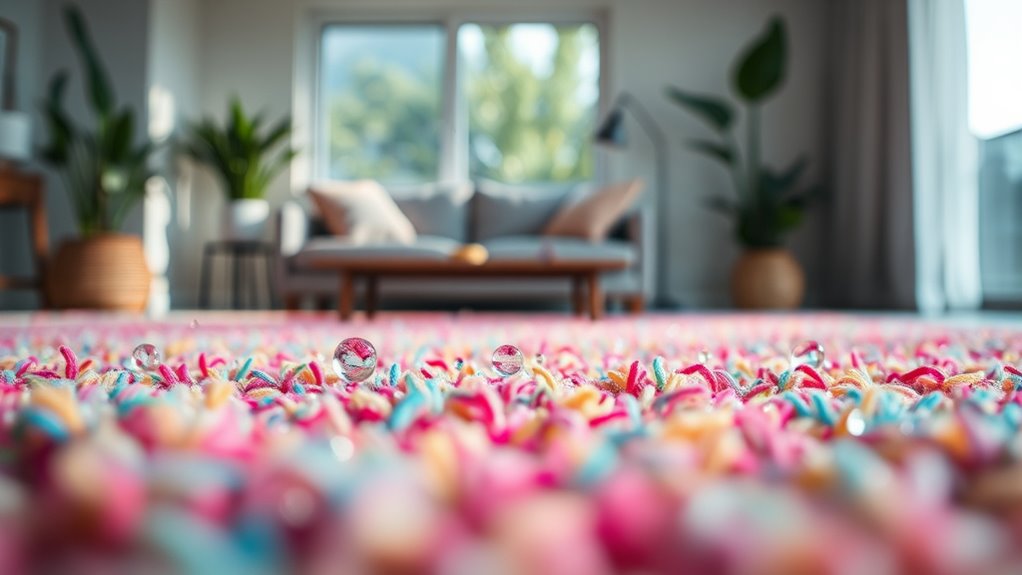
As researchers develop more advanced self-cleaning carpet fibers, considering their environmental impact becomes increasingly important. You should evaluate how these fibers are produced, used, and disposed of to minimize harm. Here are key considerations:
- Materials: Opt for eco-friendly, biodegradable substances to reduce landfill waste.
- Energy Use: Focus on manufacturing processes that consume less energy and emit fewer greenhouse gases.
- Longevity: Design fibers that last longer, decreasing the frequency of replacements and waste.
- Recycling: Develop methods to effectively recycle or repurpose old carpets with self-cleaning fibers.
- Dog Names: Choosing the right dog names can reflect your pet’s personality and breed traits, much like selecting eco-friendly materials for sustainability.
Addressing these aspects ensures that innovations align with sustainability goals, helping you reduce your ecological footprint while enjoying advanced carpet technology.
Future Applications Beyond Residential Carpets
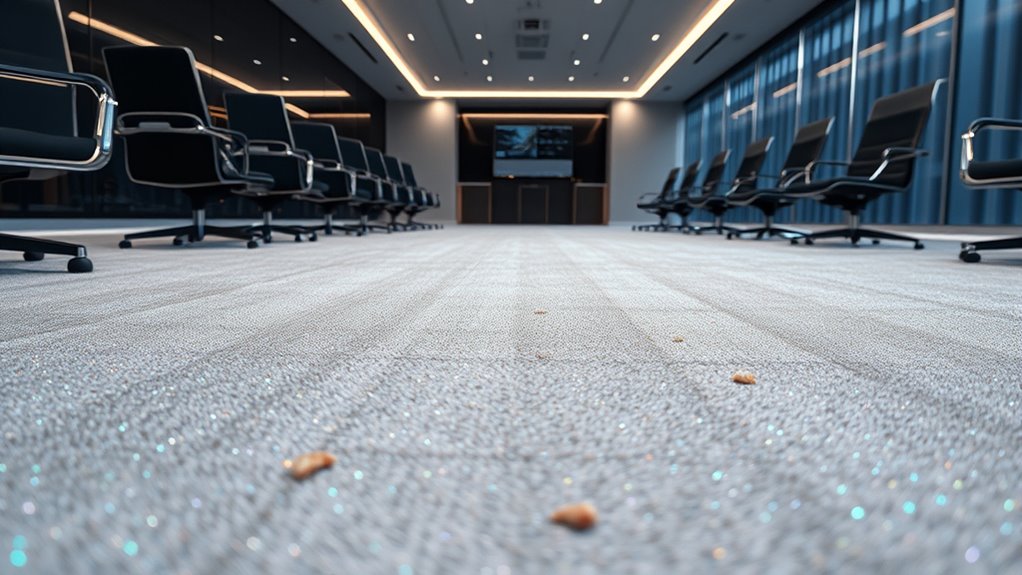
Self-cleaning carpet fibers are poised to transform industries beyond homes, opening new possibilities in commercial, industrial, and public spaces. In offices and retail stores, these fibers can reduce maintenance costs and improve cleanliness, creating a more inviting environment. Hospitals and healthcare facilities benefit from carpets that resist stains and bacteria, helping maintain sterile conditions. Public transportation hubs and airports can deploy self-cleaning carpets to handle high foot traffic while reducing cleaning downtime. Industrial facilities can utilize these fibers in areas prone to spills and dirt, minimizing disruption. Overall, these innovations promise to enhance hygiene, extend carpet lifespan, and lower upkeep efforts across various sectors, making self-cleaning fibers a versatile solution for diverse environments where cleanliness and durability are critical.
How Self-Cleaning Carpets Will Change Home Maintenance
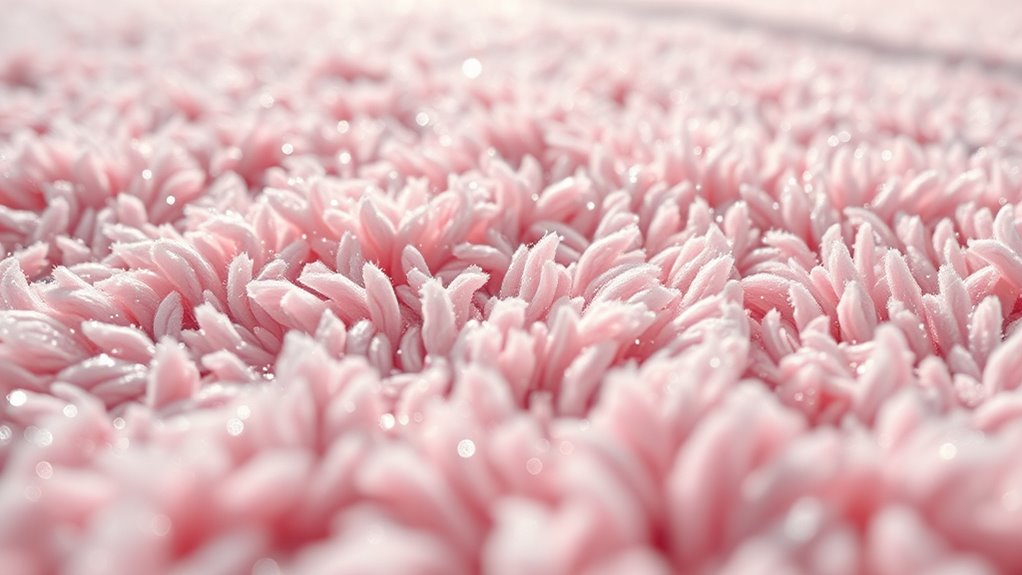
Self-cleaning carpets are set to revolutionize home maintenance by markedly reducing the time and effort needed for regular cleaning. With these carpets, you won’t need to vacuum daily or worry about stubborn stains. Instead, you’ll notice benefits like:
- Less frequent deep cleans, saving you hours each month
- Reduced use of harsh chemicals, making your home safer
- Easier removal of dirt and spills through nanotechnology activation
- Longer carpet lifespan, saving money on replacements
This technology means your home stays fresher and cleaner with minimal effort. You won’t have to spend weekends scrubbing or renting cleaning machines. Instead, your carpets will do much of the work themselves, giving you more time for the things you enjoy.
The Road Ahead: Innovations and Market Adoption
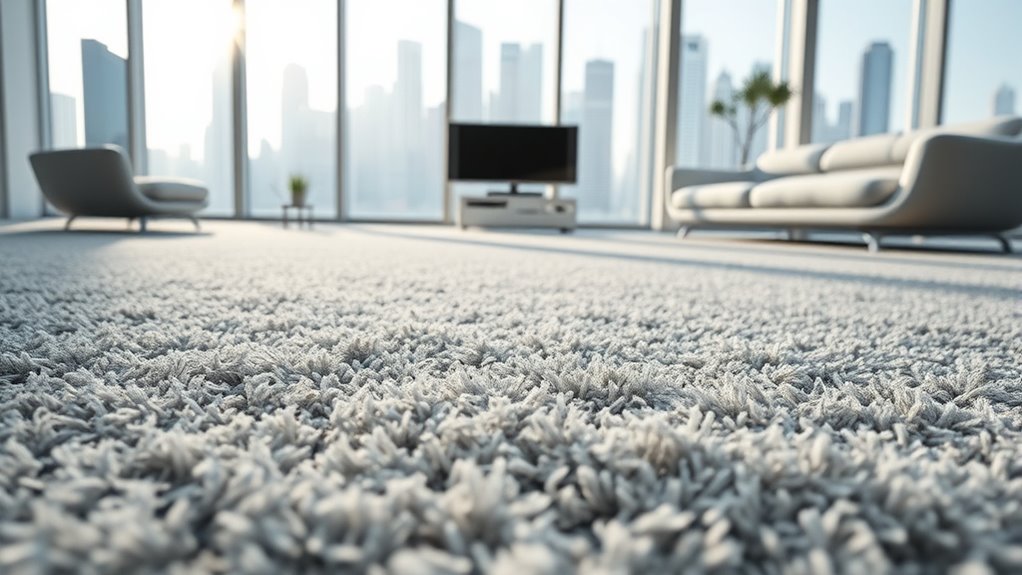
While the technology behind self-cleaning carpets is rapidly advancing, widespread market adoption will depend on overcoming manufacturing challenges and cost barriers. Industry players are investing in scalable production methods, aiming to bring prices down. Consumer acceptance hinges on proving durability and safety. Innovations like improved nanomaterials and eco-friendly coatings will accelerate adoption, but regulatory approvals and consumer education are *vital*. To visualize the landscape, consider this table:
| Challenge | Solution |
|---|---|
| High manufacturing costs | Developing cost-efficient production techniques |
| Durability concerns | Enhancing fiber resilience through new materials |
| Market acceptance | Educating consumers on long-term benefits |
| Regulatory hurdles | Gaining safety certifications and standards |
These steps will shape how quickly self-cleaning carpets become mainstream.
Frequently Asked Questions
How Long Do Self-Cleaning Fibers Typically Last Before Needing Replacement?
You wonder how long self-cleaning fibers last before replacing them. Typically, these fibers are designed to be durable, often lasting between 5 to 10 years with proper maintenance. However, their lifespan can vary depending on usage, foot traffic, and cleaning routines. You’ll want to follow the manufacturer’s guidelines and care instructions to maximize their longevity, ensuring your carpets stay fresh and clean for as long as possible.
Are Self-Cleaning Carpets Safe for Pets and Children?
Your concern about safety is valid—think of self-cleaning carpets as a guardian angel for your home. They’re generally safe for pets and children because they’re designed with non-toxic, eco-friendly materials. However, it’s wise to check specific product labels and manufacturer info, as some might have special features or ingredients. Overall, these carpets aim to keep your space cleaner and safer, making your home a healthier haven.
What Is the Cost Comparison Between Self-Cleaning and Traditional Carpets?
You wonder how self-cleaning carpets compare in cost to traditional ones. Generally, self-cleaning carpets tend to be more expensive upfront due to advanced technology. However, they can save you money over time by reducing cleaning needs and prolonging carpet life. Traditional carpets may be cheaper initially, but ongoing cleaning and maintenance costs can add up. Ultimately, weigh the higher initial investment against potential savings in maintenance and longevity.
Can Self-Cleaning Fibers Be Integrated Into Existing Carpet Designs?
You might think integrating self-cleaning fibers into existing carpets is tough, but it’s actually quite feasible. Manufacturers are developing adaptable coatings and fiber treatments that can be added during production or even retrofitted later. This means you don’t need to replace your entire carpet. With some upgrades, your current carpet can gain self-cleaning features, making maintenance easier and extending its lifespan without a complete overhaul.
How Do Self-Cleaning Fibers Perform in Extreme Weather Conditions?
You wonder how self-cleaning fibers perform in extreme weather. These fibers are designed to withstand various conditions, but their effectiveness can vary. In hot, humid climates, they help resist mold and bacteria, while in freezing temperatures, they maintain their cleaning properties without damage. Proper installation and maintenance are vital to guarantee ideal performance. Overall, they’re built to handle tough weather, but checking product specifics helps confirm they meet your needs.
Conclusion
As self-cleaning carpet fibers become more advanced, you’ll find maintaining clean floors easier than ever. While challenges remain, embracing these innovations means you’re not fighting a losing battle against dirt. Stay ahead of the curve and don’t put all your eggs in one basket—future tech is shaping a smarter, more sustainable home. With each new breakthrough, you’ll see that sometimes, the best way to stay clean is to let the technology do the dirty work for you.
